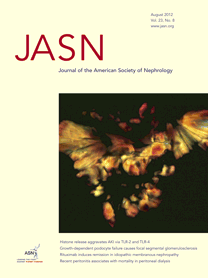JASN:2型糖尿病患者尿蛋白排泄与心脏问题风险
2013-05-06 Beyond 生物谷
2型糖尿病患者,任何程度可测的尿蛋白排泄,即使是在被认为是正常范围内也会增加患者出现心脏问题的风险,据一项发表在Journal of the American Society of Nephrology (JASN)杂志上的最新研究证实,这一发现可能有助于确定哪些人应被视为需服用心脏保护药物的患者。 有些2型糖尿病患者会出现一些肾脏问题,导致他们的尿液白蛋白排泄量增加,这种情况称为蛋白尿。这些病
2型糖尿病患者,任何程度可测的尿蛋白排泄,即使是在被认为是正常范围内也会增加患者出现心脏问题的风险,据一项发表在Journal of the American Society of Nephrology (JASN)杂志上的最新研究证实,这一发现可能有助于确定哪些人应被视为需服用心脏保护药物的患者。
有些2型糖尿病患者会出现一些肾脏问题,导致他们的尿液白蛋白排泄量增加,这种情况称为蛋白尿。这些病人比其他糖尿病患者和一般人群有一个较的心脏问题高风险如易出现心脏病发作、中风、心脏衰竭等,其他糖尿病患者和一般人群白蛋白尿是正常的,尿白蛋白排泄水平小于20μg/分钟。研究人员想知道任何水平的白蛋白排泄例如一个被认为是正常水平的排泄量是否可能会增加糖尿病患者出现心脏问题的风险。
Giuseppe Remuzzi,MD说:知道是否蛋白尿水平上有差异对于区分哪些人需要心脏保护干预将是非常重要的,这是一个重大的健康问题,因为白蛋白尿不正常的糖尿病患者占糖尿病人群中至少90%以上。Remuzzi博士与Piero Ruggenenti,MD等人通过对1,208名白蛋白尿正常的2型糖尿病患者平均随访9.2年研究评估了白蛋白排泄水平与心脏问题之间的关系。
研究人员发现,任何水平的可测量的白蛋白排泄会显著增加心脏风险:研究开始时,每1微克/分钟的白蛋白排泄的患者遇到心脏问题的风险会明显增高。但当研究者关注到服用降压药血管紧张素转换酶抑制剂的患者亚群时,他们没有发现白蛋白排泄水平和心脏病风险之间有联系。这表明,血管紧张素转换酶抑制剂具有心脏保护性能。
与糖尿病相关的拓展阅读:
- JAMA:研究支持对糖尿病患者进行更强力的抗血小板治疗
- Obes Surg:减重手术可能不能“治愈”糖尿病
- Cell Metab:新的血清标志物提前数年预测糖尿病风险
- Circulation:精氨酸酶抑制剂治疗糖尿病患者并发症
- Diabetologia:维生素D缺乏与1型糖尿病
- JBC:维生素D或可抑制糖尿病患者动脉的阻塞 更多信息请点击:有关糖尿病更多资讯

Measurable Urinary Albumin Predicts Cardiovascular Risk Among Normoalbuminuric Type 2 Diabetics
Micro- or macroalbuminuria is associated with increased cardiovascular risk factors among patients with type 2 diabetes, but whether albuminuria within the normal range predicts long-term cardiovascular risk is unknown. We evaluated the relationships between albuminuria and cardiovascular events in 1208 hypertensive, normoalbuminuric patients with type 2 diabetes from the BErgamo NEphrologic Diabetes Complication Trial (BENEDICT), all of whom received angiotensin-converting enzyme inhibitor (ACEI) therapy at the end of the trial and were followed for a median of 9.2 years. The main outcome was time to the first of fatal or nonfatal myocardial infarction; stroke; coronary, carotid, or peripheral artery revascularization; or hospitalization for heart failure. Overall, 189 (15.6%) of the patients experienced a main outcome event (2.14 events/100 patient-years); 24 events were fatal. Albuminuria independently predicted events (hazard ratio [HR], 1.05; 95% confidence interval [CI], 1.02–1.08). Second-degree polynomial multivariable analysis showed a continuous nonlinear relationship between albuminuria and events without thresholds. Considering the entire study population, even albuminuria at 1–2 μg/min was significantly associated with increased risk compared with albuminuria <1 μg/min (HR, 1.04; 95% CI, 1.02–1.07). This relationship was similar in the subgroup originally randomly assigned to non-ACEI therapy. Among those originally receiving ACEI therapy, however, the event rate was uniformly low and was not significantly associated with albuminuria. Taken together, among normoalbuminuric patients with type 2 diabetes, any degree of measurable albuminuria bears significant cardiovascular risk. The association with risk is continuous but is lost with early ACEI therapy.
作者:Beyond
版权声明:
本网站所有注明“来源:梅斯医学”或“来源:MedSci原创”的文字、图片和音视频资料,版权均属于梅斯医学所有。非经授权,任何媒体、网站或个人不得转载,授权转载时须注明“来源:梅斯医学”。其它来源的文章系转载文章,本网所有转载文章系出于传递更多信息之目的,转载内容不代表本站立场。不希望被转载的媒体或个人可与我们联系,我们将立即进行删除处理。
在此留言






好文章,超赞
124
#ASN#
31
#排泄#
42
#尿蛋白#
33
#2型糖尿病患者#
45